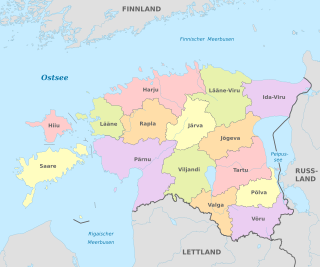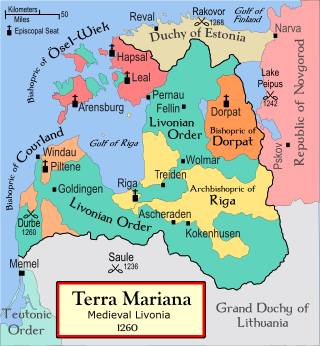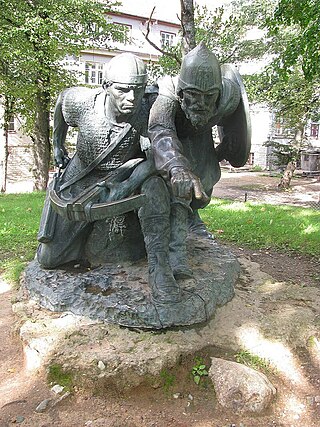
Viljandi is a town and municipality in southern Estonia with a population of 17,407 in 2019. It is the capital of Viljandi County and is geographically located between two major Estonian cities, Pärnu and Tartu. The town was first mentioned in 1283, upon being granted its town charter by Wilhelm von Endorpe. The town became a member of the Hanseatic League at the beginning of the 14th century, and is one of five Estonian towns and cities in the league. The once influential Estonian newspaper Sakala was founded in Viljandi in 1878.

Suure-Jaani is a town in the northern part of the county of Viljandimaa in Põhja-Sakala rural municipality, 25 kilometres north of the town of Viljandi. Until 2017, Suure-Jaani was the administrative centre of Suure-Jaani rural municipality.

Lembitu was an ancient Estonian king from Sakala County and military leader in the struggle against German crusaders at the beginning of the 13th century. He is the only Estonian pre-Crusade ruler, about whom some biographical information is known.

The counties of Estonia are the state administrative subdivisions of Estonia. Estonian territory is composed of 15 counties, including 13 on the mainland and 2 on islands. County governments were abolished at the end of 2017, with their duties split between state authorities and local governments, and nowadays counties have no noteworthy independent competences. Counties are composed of municipalities of two types: urban municipalities or towns, and rural municipalities or parishes, which are by law required to cooperate in development of their county.

Saare County is one of 15 counties of Estonia. It consists of Saaremaa, the largest island of Estonia, and several smaller islands near it, most notably Muhu, Ruhnu, Abruka and Vilsandi. The county borders Lääne County to the east, Hiiu County to the north, and Latvia to the south. In 2022, Saare County had a population of 31,292, which was 2.4% of the population of Estonia.

The Livonian Chronicle of Henry is a Latin narrative of events in Livonia and surrounding areas from 1180 to 1227. It was written c. 1229 by a priest named Henry. Apart from some references in Gesta Danorum – a patriotic work by the 12th-century Danish historian Saxo Grammaticus – and few mentions in the Primary Chronicle compiled in Kievan Rus', the Chronicle of Henry is the oldest known written document about the history of Estonia and Latvia.

Chud or Chude is a term historically applied in the early East Slavic annals to several Baltic Finnic peoples in the area of what is now Estonia, Karelia and Northwestern Russia. It has also been used to refer to other Finno-Ugric peoples.

Caupo of Turaida, Kaupo or Kaupo Lieven, sometimes Kubbe was a leader of the Finnic-speaking Livonian people in the beginning of the 13th century, in what are now parts of Latvia and Estonia by the Gulf of Riga. He is sometimes called a 'King of Livonia', the Chronicle of Henry of Livonia refers to him as quasi rex, 'like a king.

The Bishopric of Dorpat was a medieval prince-bishopric, i.e. both a diocese of the Roman Catholic Church and a temporal principality ruled by the bishop of the diocese. It existed from 1211 until 1558, generally encompassing the area that now comprises Tartu County, Põlva County, Võru County, and Jõgeva County in Estonia. The prince-bishopric was a sovereign member of the Holy Roman Empire and part of the Livonian Confederation until its dissolution in 1561.
Ugaunians or Ugannians, referred to as Chudes by the earliest Russian chronicles, were a historic Finnic people inhabiting the southern Estonian Ugandi County that is now Tartu, Põlva, Võru and Valga counties of Estonia.

Ugandi was an independent county between the east coast of Lake Võrtsjärv and west coast of Lake Pskov, bordered by Vaiga, Mõhu, Nurmekund, Sakala, Tālava, and The Principality of Pskov. Ugandi had an area of approximately 3000 hides. Ugandi corresponded roughly to the present Estonia's territory of Võru County, Põlva County and half of Tartu County and Valga County, as well as Petseri County.

Vyachko, also known as Vetseke, was the prince of Koknese (Kuikenos). He later became the prince of Yuryev while in the service of Novgorod, which was the last Russian stronghold in Estonia. He died during the defense of the city against the Livonian Brothers of the Sword in 1224.

The Livonian crusade consists of the various military Christianisation campaigns in medieval Livonia – modern Latvia and Estonia – during the Papal-sanctioned Northern Crusades in the 12th–13th century.

The Varbola Stronghold was the largest circular rampart fortress and trading centre built in Estonia, in Harju County in the 10th – 12th centuries. Parts of the ruins of the 580-metre (1,900 ft) long and 8-to-10-metre high limestone wall of the fortress stand to this day. The long gateways with multiple gates were built to defend the entrances. In these sections higher defensive towers were erected. There was a 13-metre (43 ft) deep well in the middle of the fortress and the territory held about 90 structures with furnaces for accommodation built with limestone floors and foundations.
The Pskov Land was a historical region in the north-west of medieval Russia centred around the city of Pskov. It was a vassal state of various Rus' states and had a measure of independence as Pskov Republic before being annexed by the Grand Duchy of Moscow. It had an important role in the trade and conflicts between Russia and its western neighbours.

Mõtsa Pūol or Metsepole was a medieval Livonian county inhabited by the Finnic-speaking Livonians, situated on the east coast of the Gulf of Riga, in most part at the northwest of the Vidzeme region of what is now Latvia, and including some adjacent areas in the present-day Pärnu County of Estonia. Metsepole was bordered by the ancient Estonian Sakala County to the north, Latgalian Tālava to the east and Livonian county of Turaida to the south.

Tālava was a Latgalian country in the northern Vidzeme and northern Latgale region of modern-day Latvia. It was bordered by the Latgalian Principality of Jersika to the south, the Livonian counties of Metsepole and Idumeja to the west, the Estonian counties of Sakala and Ugandi to the north and the Russian Novgorod Republic to the east.
Rūsiņš of Satekle was a Latgalian duke in the early 13th century who is several times mentioned in ancient sources due to his activities in Livonian Crusade.
The Izborsk and Pskov campaign was a military conflict occurring in September 1240 in the Pskov Land. An alliance of the Bishopric of Dorpat, the Livonian Order, and the pretender-prince Yaroslav Vladimirovich of Pskov besieged and conquered the Pskovian border fortress of Izborsk. After Pskovian defenders failed to retake the town, the allied forces advanced to the capital Pskov itself, compelling it to surrender.















